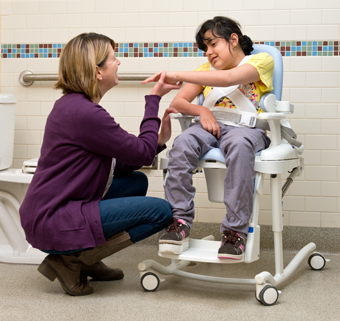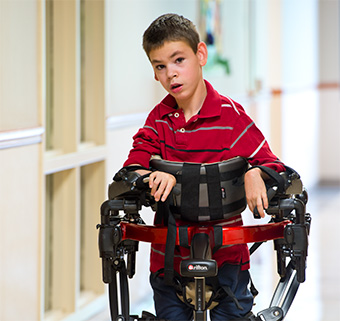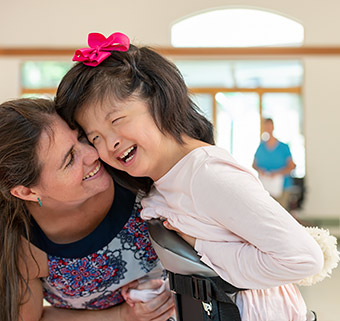The MOVE Curriculum as a Task-Oriented Approach
| October 2015 Children with severe disabilities have many complex needs. One of the most evident is a lack of motor control that prevents them from accomplishing functional movement needed for activities of daily life. Therefore, an urgent need for this population is to develop therapeutic approaches that emphasize functional movement and promote a higher quality of life. I suggest that a task-oriented approach is the most appropriate for these children. And I find the MOVE Curriculum an excellent example of this approach in action.
Children with severe disabilities have many complex needs. One of the most evident is a lack of motor control that prevents them from accomplishing functional movement needed for activities of daily life. Therefore, an urgent need for this population is to develop therapeutic approaches that emphasize functional movement and promote a higher quality of life. I suggest that a task-oriented approach is the most appropriate for these children. And I find the MOVE Curriculum an excellent example of this approach in action.
5 Common Features of Task-Oriented Approaches
The MOVE Curriculum shares many concepts with the well-known major task-oriented approaches as developed by Horak, Carr & Shepherd, and Shumway-Cook & Woollacott. Although there are slight differences in emphasis and in the details of these three therapeutic approaches, they all share many essential features. I will discuss MOVE in relation to each of the five features common to all of these approaches.
1. A systems view of motor control in which movement is organized around task goals:
The MOVE curriculum was not based on any specific theory of motor control, but was developed empirically to meet the needs of students with severe disabilities. Nonetheless, the suggestions for selecting goals are in accord with a systems view of motor control. Before beginning practice of any motor skills, the curriculum advises the team to “select specific functional activities that the student needs to perform.” (Bidabe, 1999, p.26) These functional activities are used as the goals for intervention and are also based on the child’s desires or those of the family. In addition, the MOVE curriculum considers the following parameters which may affect movement: neurological impairments, muscle strength, range of motion, motivation, and external support.
2. An emphasis on functional movement in both assessment and treatment:
In the MOVE curriculum, assessment is accomplished through the Top-Down Motor Milestone Test, which gives the team a baseline of the functional movements the child can perform, with or without assistance. Since what we assess has an effect on guiding treatment, it is emphasized that functional tests should be used rather than developmental measures. Treatment focuses on practicing motor skills in the context of functional activities. Assistance and support is provided as needed in order for the student to be able to practice the skill. Gradually reducing the supports and assistance helps the student to gain independence.
3. A task analysis or analysis of movement strategies:
Task analysis as described in the curriculum consists of breaking down the activities selected as goals into the motor skill components required. This enables the team to make the connection from the skill levels the child currently has to the skill levels needed to perform the goal activities. In this way, the skills to be practiced and the short-term goals can be determined.
4. An emphasis on motor learning in neuro-rehabilitation, with the recognition that maximizing the amount of practice of functional motor tasks is crucial:
The MOVE curriculum starts with a focus on selecting the right skills to practice, and then moves on to describe how to practice for maximum benefit. This practice may start with another person physically helping the child to perform the movement, or manually guiding and correcting a movement pattern, but as soon as possible the child is encouraged to perform the movement actively. To maximize practice opportunities, motor skill training is integrated into the school day and occurs naturally in the course of the day’s activities. For example, practice opportunities can be found when coming in from the bus, during class time, between classes, at lunch, when going to therapy, during gym, when going to the toilet, at special events, etc. In this way MOVE shares the emphasis on motor learning described in the other task-oriented approaches mentioned earlier. As stated so well by Horak, “The nervous system will be exposed to its own bodily environment many more hours a day than the environment that includes the therapists’ hands; therefore, therapists must design intervention in which much of the practice of new motor skills occurs outside of structured therapy sessions.” (Horak, 1991, p.21)
5. A recognition of the importance of the environmental context in which movement occurs, and modification of the environmental context during practice offered as a tool to maximize motor skill learning:
Part of the MOVE curriculum is concerned with structuring the environment to allow the student to practice the skills effectively. Since many students with severe disabilities cannot maintain an upright position in sitting or standing in order to practice a variety of motor skills, they must be given external support, either by the caregiver’s hands or by equipment. In addition, stabilizing certain body segments helps the child to practice controlling movement of another segment. For example, stabilizing both upper extremities can help the child to practice head control in sitting, and securing one upper extremity can assist with more controlled functional use of the other upper extremity. External support is only one way in which the environmental context can be modified. Note that in the MOVE curriculum skills are practiced in natural environments whenever possible. This means that if the goal is to sit in a chair in the classroom, the skills are practiced in the classroom. The context can also be manipulated to increase motivation. Frequently several students practice mobility skills together in “gym” or “aerobic sessions” which can be a very motivating experience (several students, several enthusiastic staff encouraging the children). Other activities such as moving to music or playing musical instruments can also be very motivating, as can other special events or performances.
It is clear that the MOVE curriculum shares many features with task-oriented therapy approaches developed for individuals with neurological disabilities. In addition, it has the benefits of providing structured practice opportunities in the educational setting, and is specifically adapted to the needs of students with severe disabilities.
References
1. Horak, FB. Assumptions Underlying Motor Control for Neurologic Rehabilitation. In: Foundation for Physical Therapy. Contemporary Management of Motor Control Problems, Proceedings of the II STEP Conference. Alexandria, VA: Foundation for Physical Therapy; 1991:11-27.
2. Carr JH, Shepherd RB. A Motor Relearning Programme for Stroke. London: William Heinemann Medical Books; 1938.
3. Shumway-Cook A, Woollacott M. Motor Control: Theory and Practical Applications. Baltimore, MD: Lippincott Williams & Wilkins; 1995.
4. Bidabe DL. MOVE: Mobility Opportunities Via Education. Bakersfield, CA: Kern County Superintendent of Schools; 1999.




